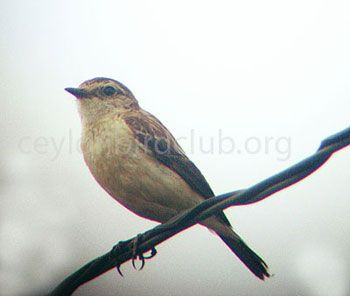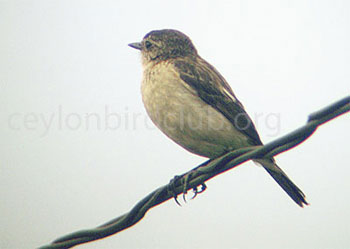


Hemantha Seneviratne, Sarath C Seneviratne - CBCN March 2013 page 82 to 86
Introduction
 The Common Stonechat Saxicola torquatus is a widely distributed species in Europe, Africa and Asia (Whistler 1949). It is a locally abundant species in the South Asian Region occurring as a resident, breeding visitor or as a passage migrant. However the bird has not been recorded in the Southern Peninsula and in Sri Lanka (Rasmussen & Anderton 2005).
The Common Stonechat Saxicola torquatus is a widely distributed species in Europe, Africa and Asia (Whistler 1949). It is a locally abundant species in the South Asian Region occurring as a resident, breeding visitor or as a passage migrant. However the bird has not been recorded in the Southern Peninsula and in Sri Lanka (Rasmussen & Anderton 2005).
Location
The location of the observation was at Maliban Mawatha, near Pinduwa Junction at Walahanduwa village in the Galle District, Southern Province of Sri Lanka (Geographical coordinates 6003’46.20’’N , 80015’09.20’’E,16 ft above sea level). The site could be accessed by proceeding 7 Km from Galle along the Udugama Road, turning to left from Ginigalthuduwa Junction and again, to the right from Pinduwa Junction.
The site was an abandoned Paddy Field covered with grass and bushes. A tarred road runs across the field. Electricity and telecommunication lines were present on sides of the road.
Optical aids used in the observation
8x42 Binoculars and a 30x75 Telescope were used to observe the bird. Photographs were taken with a compact digital camera.
The Sighting
An unusual bird had been observed by SCS on the 29th of February 2008 at 09 45 hrs, at the above location. The bird was on a telecommunication wire and came to the ground frequently for feeding. As no optical aids were available, at the time the bird was described as being slightly larger than a Pied Bushchat but much larger than a Streaked Fantail Warbler, pale brown in colour with streaks above, a blackish brown tail, a pale forehead and faint supercilium, darkish eye stripe, rufous-buff under parts, scattered streaks on upper breast, worn tail tips, black bill and legs and dark brown eyes. The claws were prominently long and a white rump was visible when the bird was on the ground. Initially, the observer thought that it was a Wheatear species (Seneviratne 2008).
The site was visited by BYHS on the following day, at the same time, with birding gear. The bird was at the same location and showed the same behaviour described by the previous observer. It was observed for nearly two hours. Optical aids elicited more details.
Detailed description of the bird observed
Appearance
 The bird was slightly larger than a Streaked Fantail Warbler. The upperparts were greyish-brown and streaked. A small white shoulder patch could be seen when perched. The rump was pale (almost white). A white wing patch as well as the pale rump was prominent in flight. Beak and legs black. A pale forehead, a faint supercilium and a dark eye-stripe were present. The throat was paler than the breast. The breast was pale brown with the colour fading towards the belly. Brown markings were present on the upper breast. The tail was dark brown with the tail-tips worn. The claws were conspicuously long.
The bird was slightly larger than a Streaked Fantail Warbler. The upperparts were greyish-brown and streaked. A small white shoulder patch could be seen when perched. The rump was pale (almost white). A white wing patch as well as the pale rump was prominent in flight. Beak and legs black. A pale forehead, a faint supercilium and a dark eye-stripe were present. The throat was paler than the breast. The breast was pale brown with the colour fading towards the belly. Brown markings were present on the upper breast. The tail was dark brown with the tail-tips worn. The claws were conspicuously long.
Behaviour and character of flight
The flight and behaviour of the bird were more or less like those of a Pied Bushchat (Saxicola caprata). Mostly, it perched on the telecommunication wire which was approximately 7 – 8 feet above the ground. This was used as a lookout position by the bird. Frequently it came to the bare ground on the sides of the tarred road to feed on insects and circled the area just as a Pied Bushchat. The bird was tame and allowed a close approach.
Other nearby birds for comparison
The Streaked Fantail Warbler Cisticola juncidis was abundant in the location and once perched close to the bird.
Discussion
The observations and subsequent reference revealed that this bird did not fit into a description of any other bird species recorded in Sri Lanka. However, birds similar to this species were carefully scrutinized to dispel any doubts. The bird was only slightly larger than a Streaked Fantail Warbler, smaller than all Wheatears recorded in the region. According to the available literature, the white shoulder patch is also absent in Wheatears. The tail pattern was also different to any of the Wheatears in the region. After referring to the literature, the bird was identified as a female of the genus Saxicola. Eight species in the genus Saxicola have been recorded in the South Asian region (Rasmussen & Anderton 2005).
The bird was distinctly smaller than the Hodgson’s Bushchat S insignis and the plumage was different to those of a Grey Bushchat, S ferreus and Jerdon’s Bushchat S jerdoni. The tail pattern was different to a Stoliczka’s Bushchat’s S macrorhynchus (Rasmussen & Anderton 2005). The Winchat S rubetra also shows a similar plumage pattern and size; however, the tail was much shorter and this species has a different pattern of flight (Jonsson 1993).
The remaining three species in the genus shows close resemblance in plumage and size (Robson 2000). The only Saxicola species recorded so far from Sri Lanka is The Pied Bushchat Saxicola caprata. The female of this species shows certain similarities to the bird in question. However, the paler plumage, white wing patch in and the paler, less streaked throat of this bird ruled out the possibility of it being the female Pied Bushchat. Further, the location is distinctly out of the range of the Pied Bushchatin Sri Lanka (There is no evidence of any internal migration of the Sri Lankan race atratus of Pied Bush Chat). The other closest species in the region is the female White-tailed Stonechat (S leucurus). In the absence of the white, distinctive supercillium and dark tail, the bird in question could not be recognized as the White-tailed Stonechat. The distribution range of the latter species is also restricted to the extreme north of peninsular India (Rasmussen & Anderton 2005).
The bird has been identified by us as a female of the race maurus of Saxicola torquatus (Common Stonechat). The Rump and tail pattern of the bird are the key identification features of the bird. These features also differentiate S. torquatus from S. leucurus (Kazmierczak & Perlo 2000). Identification was further verified (referred to as S. t maura) using the Key described by Ali and Ripley (1973).
The geographical range of the bird in the subcontinent is also different to other species of the genus. Saxicola torquatus occurs as a breeding visitor in Central and North-east Afghanistan, West and North Pakistan, Himalayas to Arunachal and in S Assam hills. However, it occurs as a migrant in many parts of India, except the extreme South (Rasmussen & Anderton 2005). Contrastingly, the other members of the genus Saxicola show a very narrow range of distribution. This fact also enhances the fact of this bird being Saxicola torquatus.
The photographs together with a detailed description, was forwarded to Mr Deepal Warakagoda for confirmation and he had sent the same to Mr Paul Holt, an expert on the birds in the region. Both have confirmed that it is a S. torquatus.
On submission to the Rarities and records committee of the Ceylon Bird Club, the committee has accepted the sighting as the first record of the Common Stonechat in Sri Lanka (Warakagoda and Siriwardane 2011) and listed it as a vagrant to Sri Lanka (Warakagoda et. Al. 2012)
Acknowledgements
The authors wish to express their gratitude to Mr Deepal Warakagoda, Mr Paul Holt, Mr Lester Perera and Dr Sampath Seneviratne for their assistance in identification of the bird. Special acknowledgement is due to Mr Deepal Warakagoda for spending his valuable time in initial discussions. The authors also thank Dr Sampath Seneviratne for review of this article and to their family members for the support given by them for birding activities.
References:
Ali, Salim and Ripley S Dillon: 1973. (Revised 1997) Handbook of the Birds of India and Pakistan. Vol.9 – Robins to Wagtails. Oxford University Press, New Delhi.
Jonsson, Lars 1993: Birds of Europe with North Africa and the Middle East. Princeton University Press, New Jersey
Kazmierczak C and Perlo B V 2000: A Field Guide to the Birds of India, Sri Lanka, Pakistan, Nepal, Bhutan, Bangaladesh and the Maldives. OM Book Service, New Delhi, India.
Robson C 2000: A field guide to the Birds of South-East Asia- Thailand, Peninsular Malaysia, Singapore, Myanmar, Laos, Vietnam, Cambodia. New Holland Publishers (UK) Ltd, London, Cape town, Sydney & Aukland.
Rasmussen, P.C & Anderton J.C. 2005: Birds of South Asia. The Ripley Guide. Vols. 1 and 2. Smithsonian Institution and Lynx Edicions, Washington D.C. and Barcelona.
Seneviratne S (2008): In Ceylon Bird Club Notes pp.43
Warakagoda D and Siriwardana U. 2011: Report from the Ceylon Bird Club for 2008 – 2011. Loris – Journal of the Wildlife and Nature Protection Society of Sri Lanka. Vol. 26 Issue 1&2 P.47. Wildlife & Nature Protection Society of Sri Lanka, Battaramulla, Sri Lanka.
Warakagoda D, Inskipp C, Inskipp T, Grimmett R (2012) Birds of Sri Lanka Christopher Helm, London.
Whistler H. 1949: Popular Handbook of Indian Birds (4th ed. Revised & enlarged by Kinnear N.B). Oliver & Boyd, Edinburgh and London.